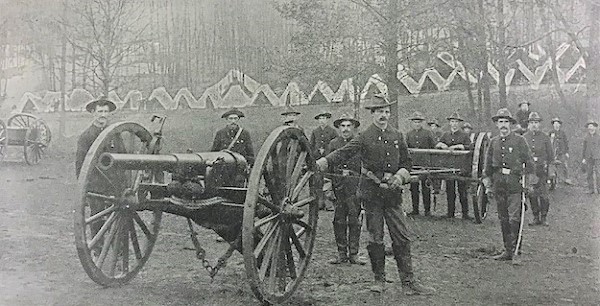


The Battery saw service in Puerto Rico during
the Spanish American War.
The History:
The Battery was formed from Battery B of the Pennsylvania National Guard stationed at Pittsburgh, Pennsylvania. Along with the remainder of the state's National Guard force, on April 27, 1898 the men of Battery B were ordered to report to Camp Hastings at Mount Gretna, Pennsylvania. On May 8, the unit was mustered into the federal service, though it would remain at Camp Hastings until May 18, when it received orders to proceed to Camp Thomas. The unit was eventually armed with four 3.2 inch rifles.
Camp Thomas was located at Chickamauga, Georgia, on the site of the Civil War battlefield of that name. Battery B reported at Camp Thomas on May 20, 1898. Originally consisting of four officers and 76 men, in June orders were received to expand the battery to include 173 enlisted men. Life in Camp Thomas was not pleasant. The camp was overcrowded, sanitation unsatisfactory and disease soon began to take its toll. The unit's commander, Capt. Alfred Hunt obtained two thirty gallon aluminum kettles for water, being rightfully untrusting of the camp water supply. Hunt was the organizer of the Pittsburgh Reduction Company, an aluminum producer, a fact which eased his efforts in obtaining the kettles. Hunt's effort paid off, with only three of his men becoming sick. Hunt also had a supply of aluminum swords made for the men.
On July 16, Battery B received orders to proceed to Newport News, Virginia where, on July 27, the unit embarked aboard the transport ROUMANIAN bound for Puerto Rico. The ROUMANIAN ran aground off Guanica, Puerto Rico for a period of about twelve hours before eventually proceeding to Ponce for the men to disembark. After disembarking, the battery was ordered forward to Arroyo, where it arrived on August 4, and thence onto Guayama, occupying the latter place on August 12. On August 13, the unit was advancing toward the impending action at El Cayey, and was in position and awaiting orders to open the action when news arrived that an armistice had been reached between the United States and Spain ending the fighting. Famed newspaper correspondent Richard Harding Davis described the scene as follows:
"They [some of the men of Battery B] were behind a gun pointed at the enemy...entrenched to the left of Guayama. The shell was in the chamber, the gunner aimed the piece and had run backward, but before it spoke, Lieutenant MacLaughlin, of the Signal Corps, galloped upon the scene shrieking, 'Cease firing, peace has been declared!' Whereat the men swore."The battle never occurred.
After the armistice was declared, the unit temporarily remained in its position, not returning to Guayama until August 23, and then proceeding to Ponce where, on September 7, the unit boarded the transport CONCHO bound for New York City. After a rough trip, the unit arrive in New York on September 15, where it was greeted by Pennsylvania Governor Hastings. It arrived in its hometown of Pittsburgh three days later to an enthusiastic welcome.
The men of the battery were given a furlough of sixty days, and were mustered out of the federal service on November 27, 1898. The war ended with the signing of the Treaty of Paris on December 10, 1898.
During its term of service, the unit suffered the loss of one enlisted man to disease.
(As a service to our readers, clicking on title in red will take you to that book on Amazon.com)
Sauers, Richard A., Pennsylvania in the Spanish-American War. (Harrisburg: Pennsylvania Capitol Preservation Committee, 1998) . 18, 64
Stewart, Adj. Gen. Thomas J., Record of the Pennsylvania Vounteers. (Harrisburg: William Stanley Ray, 1901) 771-772.
Statistical Exhibit of Strength of Volunteer Forces Called into Service During the War with Spain; with Losses from All Causes. (Washington: Government Printing Office, 1899).